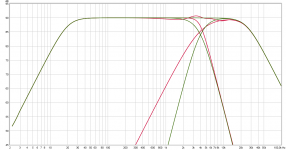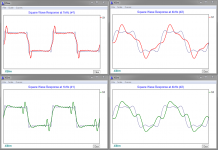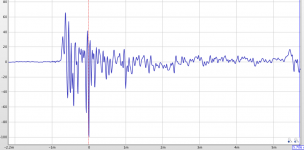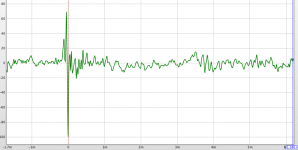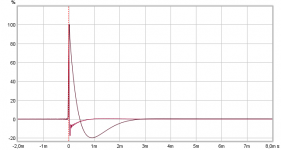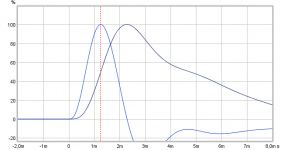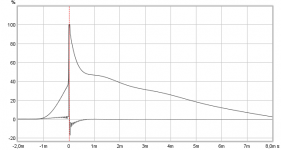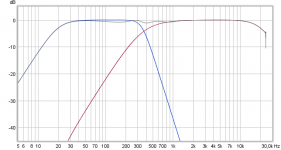Read through and found this to be very very interesting.Thanks a lot for going into so many details.I am planning to try it in my car using a 6.5 inch Midbass and a 2 Inch Full range. the Fc is going to be 1000Hz. I kind of understood everything except the delay on the Fullrange as we have different delays in car due to speakers being not equidistant from the listener. Any ideas to achieve the same will be highly appreciated.
If your full range is located farther away from your mid bass, it may be accomplishing the delay for you, given that it is not too far away. But if you are using DSP, you can tweak the delays to get good time alignment (of forst arrival) at your ears regardless.
So assuming midbass is in the door(?) and full range is on the dashboard or windshield pillar (?) the best way is to measured the delays using REW or other measurement software. The latest version of REW has ability to put a reference time mark (via auxiliary speaker) so you can get absolute time delays between speakers. Assuming speakers were on flat baffle and no offset, the delay for Harsch is set as half the time period corresponding to the XO frequency. In this case XO freq is 1kHz so period is 1ms and half if 500microseconds. That is same as 17.1cm setback of the full range behind the mid bass. Take a string and stretch it from the full range to your listening position (middle of head between ears) and do same for mid bass. If string is 17.1cm longer for full range, you have perfect time alignment for 1kHz Harsch XO. There is probably nothing magical about 1kHz, you might want to change the XO frequency to adjust this ideal delay to match. Go as low as 400Hz for the XO and a bit higher to 1.5kHz even. And if you have DSP delays, just dial it in. Finally, you have to measure it to see if it is aligned and look for tell tale clues like a sharp positive peak on a sort of triangle shape for the step response. Look for slight dip in summed response below woofer alone.
If your full range is located farther away from your mid bass, it may be accomplishing the delay for you, given that it is not too far away. But if you are using DSP, you can tweak the delays to get good time alignment (of forst arrival) at your ears regardless.
So assuming midbass is in the door(?) and full range is on the dashboard or windshield pillar (?) the best way is to measured the delays using REW or other measurement software. The latest version of REW has ability to put a reference time mark (via auxiliary speaker) so you can get absolute time delays between speakers. Assuming speakers were on flat baffle and no offset, the delay for Harsch is set as half the time period corresponding to the XO frequency. In this case XO freq is 1kHz so period is 1ms and half if 500microseconds. That is same as 17.1cm setback of the full range behind the mid bass. Take a string and stretch it from the full range to your listening position (middle of head between ears) and do same for mid bass. If string is 17.1cm longer for full range, you have perfect time alignment for 1kHz Harsch XO. There is probably nothing magical about 1kHz, you might want to change the XO frequency to adjust this ideal delay to match. Go as low as 400Hz for the XO and a bit higher to 1.5kHz even. And if you have DSP delays, just dial it in. Finally, you have to measure it to see if it is aligned and look for tell tale clues like a sharp positive peak on a sort of triangle shape for the step response. Look for slight dip in summed response below woofer alone.
That's the problem here. Midbass is in doors n full range on A pillar so full range is nearer. Another thing is how to get center image. Wouldn't changing the TA cause room Harsch delay values
Sent from my Nexus 6P using Tapatalk
hello to everyone,
i have a diy 3-way active speakers using seas excel drivers. Now i am using an analog active crossover with LR2 in all sections. The speakers are sounding fine, i have spent several months designing this crossover. (after many many simulations using minidsp).
I am interested to try the S. Harsch method but i don't know what software i will need to make some simulations or u suggest playing directly with the minidsp and measuring using REW?
i have a diy 3-way active speakers using seas excel drivers. Now i am using an analog active crossover with LR2 in all sections. The speakers are sounding fine, i have spent several months designing this crossover. (after many many simulations using minidsp).
I am interested to try the S. Harsch method but i don't know what software i will need to make some simulations or u suggest playing directly with the minidsp and measuring using REW?
Boxsim works, because one can set a runtime distance between drivers, so if one divides that distance by speed of sound in air, one gets time delay.
One general thing bout Harsch xovers tho, step response does not equal square wave one, and square wave response does not equal flat phase. The 4th order lowpass causes ringing, which impairs step response, does it not? Also, phase turn of just a lowpass, no crossover, is inaudible, because all we hear is its constant time delay. But if it rings, we can hear that.
One general thing bout Harsch xovers tho, step response does not equal square wave one, and square wave response does not equal flat phase. The 4th order lowpass causes ringing, which impairs step response, does it not? Also, phase turn of just a lowpass, no crossover, is inaudible, because all we hear is its constant time delay. But if it rings, we can hear that.
because i have never used the boxsim software can i input the real drivers responses and then play with various active filters? I have the lspcad software which is fine but it not have the bessel filters.
One can write simple text files containing
frequency TAB amplitude or phase Enter
frequency TAB amplitude or phase Enter
...
and load this into Boxsim as driver response. (I think, it calculates phase from amplitude, in case that no phase file is loaded.) What does not work in Boxsim, is making active filters by hand. But one can make a passive Bessel filter, of course. In Boxsim one can work around many things; the only three important things not possible are two different(ly driven) drivers in one enclosure, a driver tilted by a fraction of a right angle in relation to another driver and room behaviour (sound between opposing surfaces farer apart than wavelength/2Pi) such as Transmissionline enclosures.
frequency TAB amplitude or phase Enter
frequency TAB amplitude or phase Enter
...
and load this into Boxsim as driver response. (I think, it calculates phase from amplitude, in case that no phase file is loaded.) What does not work in Boxsim, is making active filters by hand. But one can make a passive Bessel filter, of course. In Boxsim one can work around many things; the only three important things not possible are two different(ly driven) drivers in one enclosure, a driver tilted by a fraction of a right angle in relation to another driver and room behaviour (sound between opposing surfaces farer apart than wavelength/2Pi) such as Transmissionline enclosures.
Last edited:
because i have never used the boxsim software can i input the real drivers responses and then play with various active filters? I have the lspcad software which is fine but it not have the bessel filters.
In LspCAD: set target as "variable slope" with a value of slope "10 db/oct". This matches fully a Bessel 12.
Maybe a stupid question, but if I have a 4kHz crossover from a 4" driver to a 3/8" dome, how much would I need to move the tweeter backwards to get the timing correctly? They'd need to be acoustically aligned in the first place, right?
It depends on where you are, i.e. if you listen from above or under or you put the speaker upside down, because usually you see polar response ( lobings...)
referred at various angles ( vertically or horizontally ) but everytime you see just the frequency response on axys ( so...for keeping everything tidy it's referred to tw's axys)
referred at various angles ( vertically or horizontally ) but everytime you see just the frequency response on axys ( so...for keeping everything tidy it's referred to tw's axys)
What I'm thinking of is a array of 6 3/8" domes crossed over to an array of 15 4" woofers. The tweeter array would be dead center of listening spot vertically, and of course in the center of the woofer array.
...if I have a 4kHz crossover from a 4" driver to a 3/8" dome, how much would I need to move the tweeter backwards to get the timing correctly? They'd need to be acoustically aligned in the first place, right?
Hope have math right 🙂 after acoustic aligned in first place then further delay tweeter 125uS or move it backward 4,2875cm.
Math is taken from S. Harsh document linked into thread's post one and say (1/4000) * 0,5 = 125uS time delay, then for distance is used speed of sound 343 meter * 0,000125 = 4,2875 cm.
That said think your XO point is so high in frq that its not very audio able if you use Harsch XO or LR4 up there, thought for this claim or postulation : ) is based on that square waves from real world speaker drivers fade out in 4-6kHz area in lack of HF bandwidth limit and can see into REW simulations that waterfall and spectrogram is very close looking be it Harsch or LR4 at 4kHz XO point. Below REW plot show amplitude sum for Harsch verse LR4 and XSim plots show those sums square waves at 1kHz plus 4kHz verse a ideal IRR 20Hz-25kHz bandpass (gray).
Attachments
I see! Thank you for those simulations.
Another question. If I reverse the Harsch XO order to 2nd order woofer 4th order tweeter, do I apply the delay to the woofer instead?
Another question. If I reverse the Harsch XO order to 2nd order woofer 4th order tweeter, do I apply the delay to the woofer instead?
I have tried reversing it and the math doesn't work out. It won't be transient perfect and the delay isn't the same. Interesting how it's not reversible.
Hi there!
Would this Harsh XO also work in a 2.1 setup?
I am currently working on a budget studio reference solution with two TML FR Satelites and a closed 8" subwoofer, the XO is a miniDSP. The system should be as linear and in-phsae as possible, that is why I am very interested in this XO design.
The Sub should start playing at 100hz and will be located beneath the table, in other words it will be further away from the listeners ears than the FR satelites.
Am I right aussuming that I would need to delay the FR drivers by 5ms (100hz time divided by two), plus the delay caused by the additional distance the subwoofer has to the listeners ears compared to the satelites?
Thanks for your help!
Would this Harsh XO also work in a 2.1 setup?
I am currently working on a budget studio reference solution with two TML FR Satelites and a closed 8" subwoofer, the XO is a miniDSP. The system should be as linear and in-phsae as possible, that is why I am very interested in this XO design.
The Sub should start playing at 100hz and will be located beneath the table, in other words it will be further away from the listeners ears than the FR satelites.
Am I right aussuming that I would need to delay the FR drivers by 5ms (100hz time divided by two), plus the delay caused by the additional distance the subwoofer has to the listeners ears compared to the satelites?
Thanks for your help!
Yes it can work but at frequencies below 120Hz, the time delay will not be so critical as speaker is already not localized and that is why 2.1 subwoofer satellite systems can work. 5ms plus time of flight delay between satellites and sub is correct. Best way is to measure impulse and step.
Thx again xrk971 for another great advice.
I will give it a try, the minidsp arrived yesterday, the satelites are build, I only need to build the sub`s enclosure.
cheers!
I will give it a try, the minidsp arrived yesterday, the satelites are build, I only need to build the sub`s enclosure.
cheers!
Well, color me impressed!
I have one of those rooms that are hard to dial in. I tried different approaches, different drivers, different positioning, different setups from closed, vented to OB.... I always had trouble... I could never get a clean impulse. It was always garbled up.
I recently got the miniDSP HD and figured that it would be the perfect time to experiment with Harsch XO.
Now, this is usually the impulse I get in this room, which is about 4m x 10m and 3m high ceilings, cement open rectangle. I was never able to get rid of this double peak, and no amount of positioning of drivers or mic seemed to help, in fact, I've seen quite worse!
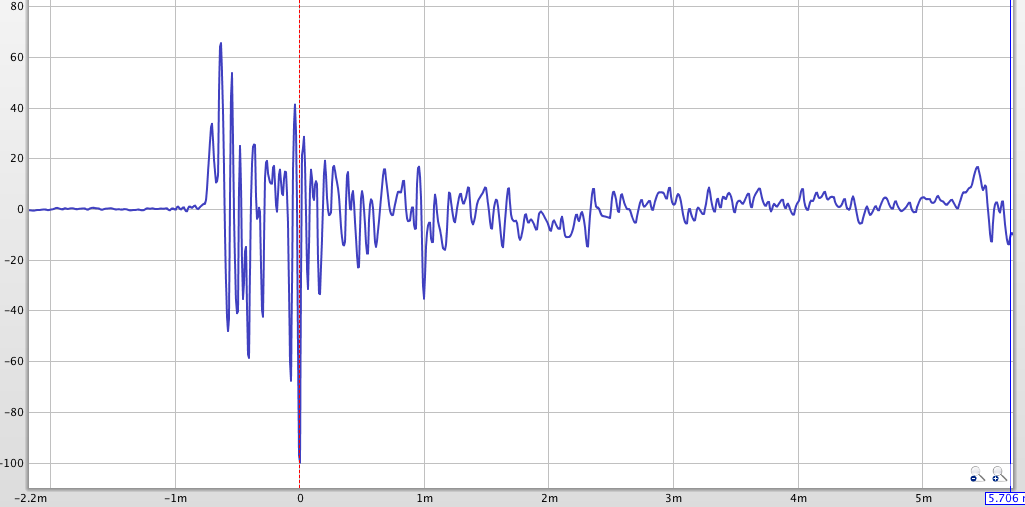
I applied a Harsch at 350Hz, and got this... now, there are a lot of artefacts before the impulse, which I don't know where they come from.
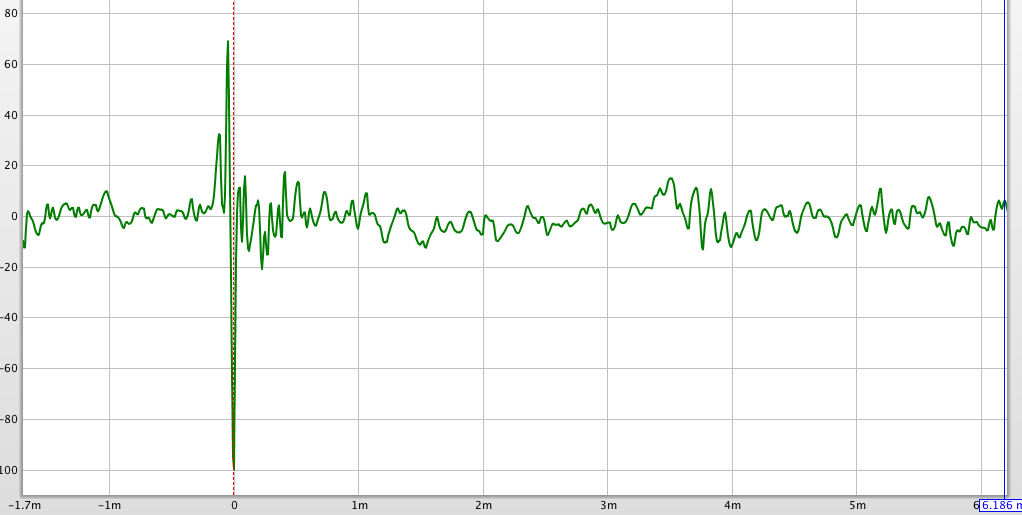
What I can say is that it does sound a lot cleaner! It's sharp, instrument location is great, it's quite enjoyable.
Also, the impulse seems inverted, but all connections are in phase, and positive is connected to positive everywhere... I checked all drivers polarity with a small 1.5V battery, and they are all fine. I'm not sure if polarity gets switched around within my mp, but that sounds pretty unlikely, wouldn't it be?
I have one of those rooms that are hard to dial in. I tried different approaches, different drivers, different positioning, different setups from closed, vented to OB.... I always had trouble... I could never get a clean impulse. It was always garbled up.
I recently got the miniDSP HD and figured that it would be the perfect time to experiment with Harsch XO.
Now, this is usually the impulse I get in this room, which is about 4m x 10m and 3m high ceilings, cement open rectangle. I was never able to get rid of this double peak, and no amount of positioning of drivers or mic seemed to help, in fact, I've seen quite worse!

I applied a Harsch at 350Hz, and got this... now, there are a lot of artefacts before the impulse, which I don't know where they come from.

What I can say is that it does sound a lot cleaner! It's sharp, instrument location is great, it's quite enjoyable.
Also, the impulse seems inverted, but all connections are in phase, and positive is connected to positive everywhere... I checked all drivers polarity with a small 1.5V battery, and they are all fine. I'm not sure if polarity gets switched around within my mp, but that sounds pretty unlikely, wouldn't it be?
Attachments
Last edited:
If you have the HD version you should give linear phase FIR filters a try 🙂.
You can make them using Rephase and load them into the miniDSP HD.
You can make them using Rephase and load them into the miniDSP HD.
Good grief! That's a vast improvement. 
As for polarity, it's likely the filter that's flipping it. We can check with software.

As for polarity, it's likely the filter that's flipping it. We can check with software.
To help trouble shoot perceval find below synthetics for Harsh XO at 350Hz where system stop bands are set 20Hz and 20kHz inside a 48kHz sample rate window. First is IR/SR mid tweeter, second is IR/SR woofer, third is IR/SR system, then amplitude overlay. If you bench each band pass their polarity direction and overall look should replicate more or less to below and mid tweeter be 1,429mS delayed seen at SR for system.
Agree Pano it was vast improvement : )
Also agree Zonneschimmel that with particular hardware box and Rephase instead of using Harsch one can set also steeper symetric slope for mid tweeter and get away using either linear phase XO points or as last step linearize phase turn coursed by XO points minimum phase turn.
Agree Pano it was vast improvement : )
Also agree Zonneschimmel that with particular hardware box and Rephase instead of using Harsch one can set also steeper symetric slope for mid tweeter and get away using either linear phase XO points or as last step linearize phase turn coursed by XO points minimum phase turn.
Attachments
- Home
- Loudspeakers
- Multi-Way
- S. Harsch XO
